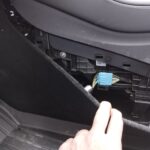Navigating the complexities of your Chevy Volt involves understanding its diagnostic systems, particularly when the check engine light illuminates. OBD2 codes are your car’s way of communicating potential issues. Among these, the P1E65 code is a specific indicator for Chevy Volt owners. This article delves into the P1E65 code, what it signifies, and provides essential advice for Volt owners encountering this diagnostic trouble code (DTC).
The P1E65 code on a Chevy Volt signals a “Hybrid/EV Battery Pack Cell Group 58 High Resistance.” This means that within the sophisticated battery system of your Volt, cell group number 58 has registered a higher than expected resistance. In simpler terms, one of the 96 cell groups, specifically number 58, is not conducting electricity as efficiently as it should.
This condition, as indicated in the original diagnostic scenario, appears to be intermittent. An intermittent fault means the problem isn’t constantly present, which can make immediate diagnosis challenging. If you’ve encountered a P1E65 code and it has disappeared, it’s important to note that the underlying condition might still exist and could reappear.
If your Chevy Volt displays a check engine light and you’ve identified a P1E65 code using a scan tool, it’s generally advisable to refrain from clearing the code yourself, especially if you are not a trained technician. Furthermore, caution should be exercised when using aftermarket scan tools, particularly unvalidated or unknown brands. There have been instances where such equipment has not only cleared DTCs but also potentially caused further complications, including loss of propulsion.
The recommended course of action when faced with a P1E65 code and a persistent check engine light is to take your Chevy Volt to a certified dealership as soon as possible. While informing the dealer about the P1E65 code can be helpful, it’s crucial to understand that dealerships rely on their own diagnostic procedures. They will need to independently read the DTCs directly from the vehicle’s modules to accurately assess the situation. Simply telling them a code might not be sufficient for initiating a repair process.
In cases where the check engine light is no longer illuminated, and the P1E65 code is not currently active, it might seem tempting to ignore the issue. However, an intermittent code like P1E65 suggests a potential underlying problem. While the car may seem to be operating normally at present, the condition could worsen. Taking your vehicle to a dealer for assessment, even without an active check engine light, could be a proactive step to prevent future issues. However, be aware that diagnosing intermittent faults requires the fault to be present. If the condition is not active during your dealer visit, they might report “No Fault Found,” as diagnosing a non-present fault is challenging using standard diagnostic procedures.
Finally, it’s worth noting the role of services like OnStar in these situations. While OnStar can provide a preliminary assessment based on DTCs, their understanding is limited to a generalized lookup table. They can advise on the severity of the issue and recommend dealer visits, but they do not possess in-depth diagnostic capabilities to resolve the intricate details behind a code like P1E65.
In Conclusion
Encountering a P1E65 code on your Chevy Volt warrants attention and a cautious approach. Avoid clearing the code yourself or using questionable aftermarket scan tools. For persistent check engine lights and P1E65 codes, a visit to a certified Chevy dealership is the most prudent step. Even with intermittent issues, professional assessment can help ensure the long-term health and reliability of your Chevy Volt’s battery system. Understanding OBD2 codes like P1E65 empowers Chevy Volt owners to make informed decisions about their vehicle’s maintenance and care.

